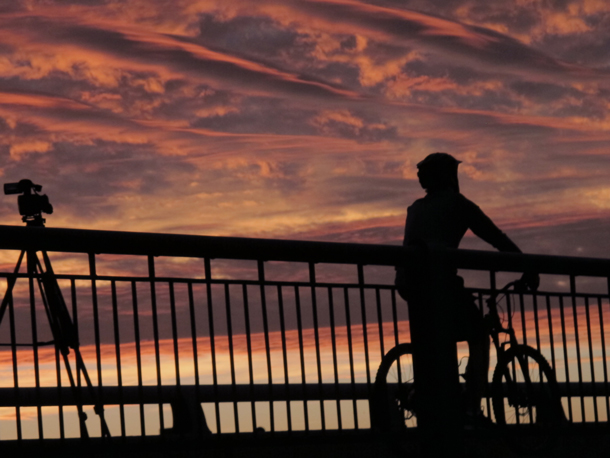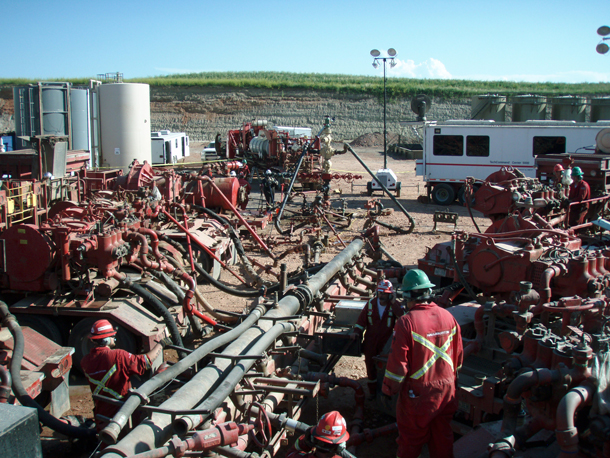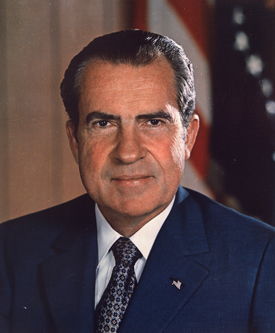Beyond the Headlines
Air Date: Week of April 17, 2020

Boston is one of three major American cities, along with Oakland and Minneapolis, to experimentally close certain through-streets to give more room to cyclists, walkers, joggers, and the one man who has been walking around Living on Earth intern Isaac Merson’s neighborhood with a sousaphone. (Photo: rik-shaw 黄包车, Flickr, CC by 2.0)
In this Earth Day edition of Beyond the Headlines, Peter Dykstra and Host Steve Curwood discuss how street closures in some cities are giving people safer outdoor spaces while practicing corona virus social distancing. Meanwhile, a preliminary NOAA study finds that methane emissions are at an all-time high, so they break down what that means for the climate, and what some of the causes might be. Finally, the dynamic duo looks back 26 years to Earth Day 1994, the day that President Richard M. Nixon died, and discuss his role as a reluctant but effective environmental president.
Transcript
CURWOOD: Well, it's that time of the program when we take a look beyond the headlines with the indomitable Peter Dykstra. Peter's an editor with environmental health news that's ehn.org and dailyclimate.org. And he's on the line now from Atlanta, Georgia. Hey there, Peter, what's going on?
DYKSTRA: Hi, Steve. Well, as we deal with the COVID-19 crisis, it's justifiably dominating all the headlines. But there are some little things happening that we ought to notice, like an inventive thing that at least three major American cities are trying out to help their populations cope.
CURWOOD: And that would be?
DYKSTRA: Well Boston, Minneapolis, and Oakland have temporarily banned through traffic on certain streets, giving hikers, joggers, walkers and bicyclists, a little extra elbow room so they can get out and maintain the six feet of social distance.
CURWOOD: And Peter, I'm going to make a prediction that those bicyclists having had a chance to get around without getting so threatened by cars are going to really push back when this virus thing is over to have more access.
DYKSTRA: Yeah, and some of those empty streets have another positive benefit. Not that it makes up for all of the tragedy and all of the death and suffering of Coronavirus. But the air in American streets and around the world is much, much clearer than it normally is. There are some other cities like Washington DC, that considered doing the same thing but rejected it. Washington DC Mayor Marion Bowser said there needs to be limits on how we encourage people to gather outside. But the clean air and the decline of as much as two thirds or more vehicle traffic is one little positive in all of this.
CURWOOD: Okay, Peter. So what else do we have this week?

A fracking job underway in the Bakken formation of North Dakota. Fracking, or hydraulic fracturing, is a process by which oil and natural gas are extracted after underground rock formations are fractured by pressurized water. While researchers have identified that there is a significant amount of methane released during this process, the true extent is still uncertain. (Photo: Joshua Doubek, Wikimedia Commons, CC by S.A. 3.0)
DYKSTRA: Methane levels, according to a preliminary NOAA study are at an all-time high. Methane of course is a far more potent heat-trapping greenhouse gas than CO2. Some believe it's 80 times as potent as carbon dioxide, even though it doesn't last as long in the atmosphere. It does a lot of damage in the short term.
CURWOOD: Yeah, the short term being 1020 years, which is when we have to get this right. So where's all this methane coming from?
DYKSTRA: Some of it comes from an increase in fracking. There are mostly untold methane releases from fracking, the wildly popular method of oil and gas drilling that's taken hold and changed the face of the oil industry. But one of the primary sources is the melting of Arctic permafrost and methane released from vegetation that's been trapped and frozen for as much as 10s of thousands of years. Also releases from the ocean: methane from decaying sea life is a big contributor as well. It could be one step back even as we take one step forward in battling to control climate change.
CURWOOD: It's a very scary one, Peter, because as more methane comes off the permafrost, it'll make things warmer, which will then make more methane come off the permafrost, we could stop fracking, but I don't know how we stopped that.
DYKSTRA: Right.
CURWOOD: What do you see when you look back in history?

Richard M. Nixon, 37th President of the United States, had a wide-ranging legacy of signing environmental policy into law, despite mixed personal feelings about environmentalists (Photo: U.S. National Archives and Records Administration, Wikimedia Commons, Public Domain)
DYKSTRA: Well, as we've discussed a few times before in the show, there's no president that has been more environmentally active, not just in our lifetimes, but in history than Richard Milhouse Nixon, the guy that signed the Clean Air Act, the Endangered Species Act, the Marine Mammal Protection Act, and on April 22, 1994, President Nixon died on Earth Day.
CURWOOD: You know, I'm not sure that Nixon would care to be remembered as the environmentally active president. I don't know how much he really bought into it.
DYKSTRA: Well, what he might say is I am not a tree hugger. And actually what he did say in a meeting with the big three automakers' CEOs is that environmentalists wanted to quote, live like a bunch of damn animals. They can't take away that impressive string of environmental achievements, including the founding of NOAA, the founding of EPA all happened on Nixon's watch, and he died on Earth Day in 1994.
CURWOOD: Thanks, Peter. Peter Dykstra is an editor with environmental health news that's ehn.org. And dailyclimate.org. Happy Earth Day, Peter and stay safe,
DYKSTRA: Happy Earth Day and everybody stays safe and healthy.
CURWOOD: And there's more on these stories that the living on earth website LOE.org
Links
Living on Earth wants to hear from you!
Living on Earth
62 Calef Highway, Suite 212
Lee, NH 03861
Telephone: 617-287-4121
E-mail: comments@loe.org
Newsletter [Click here]
Donate to Living on Earth!
Living on Earth is an independent media program and relies entirely on contributions from listeners and institutions supporting public service. Please donate now to preserve an independent environmental voice.
NewsletterLiving on Earth offers a weekly delivery of the show's rundown to your mailbox. Sign up for our newsletter today!
 Sailors For The Sea: Be the change you want to sea.
Sailors For The Sea: Be the change you want to sea.
 The Grantham Foundation for the Protection of the Environment: Committed to protecting and improving the health of the global environment.
The Grantham Foundation for the Protection of the Environment: Committed to protecting and improving the health of the global environment.
 Contribute to Living on Earth and receive, as our gift to you, an archival print of one of Mark Seth Lender's extraordinary wildlife photographs. Follow the link to see Mark's current collection of photographs.
Contribute to Living on Earth and receive, as our gift to you, an archival print of one of Mark Seth Lender's extraordinary wildlife photographs. Follow the link to see Mark's current collection of photographs.
 Buy a signed copy of Mark Seth Lender's book Smeagull the Seagull & support Living on Earth
Buy a signed copy of Mark Seth Lender's book Smeagull the Seagull & support Living on Earth

